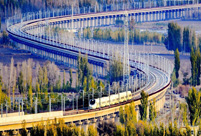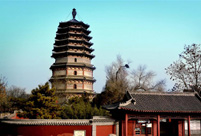

BEIJING, March 1 -- China's manufacturing activity has fallen to its lowest level in four years, pointing to the need for more policy support to bolster economic growth and push structural reforms.
The purchasing managers' index (PMI) came in at 49, down from January's 49.4, the National Bureau of Statistics (NBS) and the China Federation of Logistics and Purchasing said on Tuesday.
A reading above 50 indicates expansion, while a reading below 50 reflects contraction.
The figure contracted for a seventh straight month in February and it was the lowest reading since November, 2011, as China is seeking new economic growth engines amid a campaign to cut industrial overcapacity.
NBS statistician Zhao Qinghe attributed the retreat to slowing factory activity during the Chinese Lunar New Year holiday in early February, as well as the trimming of industrial capacity.
In breakdown, the sub-index measuring production stood at 50.2, down 1.2 points from a month earlier, and that for new orders settled at 48.6, down 0.9 points.
A separate survey by financial information service provider Markit sponsored by financial media company Caixin also showed deterioration in Chinese manufacturers' operating conditions.
The Caixin General China Manufacturing Purchasing Managers' Index (PMI), edged down to 48 in February from January's 48.4.
"The index reading for all key categories, including output, new orders and employment, signaled that conditions worsened, in line with signs that the economy's road to stability remains bumpy," said He Fan, chief economist at the Caixin Insight Group.
The disappointing data came after China's economy grew by 6.9 percent year on year in 2015, its lowest annual expansion in a quarter of a century.
"The economy is still in the phase of bottoming out," said Zhang Liqun, researcher with the State Council's Development Research Center, adding that the weak data in February is not necessarily indicative of a trend as there are seasonal effects at work, with the holiday disrupting production activities.
Chen Zhongtao, analyst with the China Logistics Information Center, pointed out some bright spots behind the weak data that may show restructuring efforts are bringing about positive changes.
These included the fact that the PMI raw materials purchase price index jumped 5.1 points to 50.2, returning to expansion for the first time since August 2014, consistent with the recent rebound in upstream industrial prices.
Meanwhile, the business activity expectations index jumped 13.5 points to 57.9, more than the seasonal rise in the past few years, suggesting manufacturer expectations improved.
Zhang forecast that the economy would stabilize as the effects of various pro-growth policies filter through.
Authorities' growth-supportive policy stance was reinforced on Monday as the central bank announced it would lower the reserve requirement ratio (RRR) for commercial banks by 0.5 percentage points, the first such cut this year.
Speaking during two days of meetings in Shanghai between financial ministers and central bankers of G20 economies, Finance Minister Lou Jiwei said he saw more room to expand fiscal policy and predicted an increased budgetary deficit this year.
"Looking ahead, fiscal policy will likely become more expansionary in 2016, with the actual fiscal deficit ratio expected to expand further from 2015's 3.5 percent. Monetary policy will likely remain loose," said China Int. Capital Corp in a report.
 China has world's largest high-speed rail network
China has world's largest high-speed rail network Top beauties in Chinese provinces
Top beauties in Chinese provinces 600 people attend Lusheng playing contest in S China
600 people attend Lusheng playing contest in S China Engineer troop builds bridge in real combat conditions
Engineer troop builds bridge in real combat conditions You can urinate in public in Chongqing
You can urinate in public in Chongqing Rice terrace scenery in southwest China's Yunnan
Rice terrace scenery in southwest China's Yunnan 2016 Miss Chinatown USA pageant held in San Francisco
2016 Miss Chinatown USA pageant held in San Francisco Ancient pagodas across China
Ancient pagodas across China Wedding dress show up in the air
Wedding dress show up in the air Top 20 hottest women in the world in 2014
Top 20 hottest women in the world in 2014 Top 10 hardest languages to learn
Top 10 hardest languages to learn 10 Chinese female stars with most beautiful faces
10 Chinese female stars with most beautiful faces China’s Top 10 Unique Bridges, Highways and Roads
China’s Top 10 Unique Bridges, Highways and Roads G20 pledges to avoid currency war
G20 pledges to avoid currency war Pro-independence forces rip Taiwan apart
Pro-independence forces rip Taiwan apart China’s ‘fakes fighters’ sue companies over knockoffs
China’s ‘fakes fighters’ sue companies over knockoffs Net watchdog closes tycoon’s social media accounts
Net watchdog closes tycoon’s social media accountsDay|Week